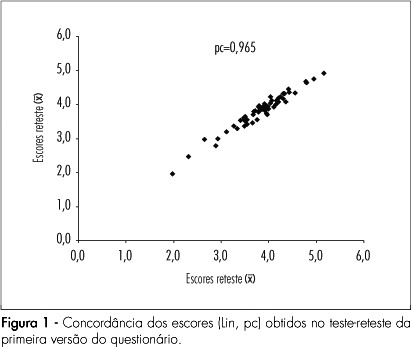Summary
Revista Brasileira de Ginecologia e Obstetrícia. 2015;37(10):473-479
DOI 10.1590/SO100-720320150005354
To validate the instrument Body Image Relationship Scale (BIRS) for Brazilian women with breast cancer
The instrument was administered by trained interviewers to 139 women who used the Brazilian Unified Health System (SUS). All of them had been submitted to cancer treatments between 2006 and 2010. The instrument was validated considering internal consistency and reliability. In order to compare the techniques, the same factorial analysis as used in the original paper was carried out
The Spearman-Brown correlation value was 0.8, indicating high internal reliability. The Cronbach's alpha found was 0.9, indicating a high level of internal consistency. Factorial analysis showed that four items had low factorial load and no discriminatory power, and another five items were relocated to other factors. When the instrument was applied, it showed variability to that of the original instrument
The Brazilian version of the Body Image Relationship Scale (BIRS), namedEscala de Relacionamento e Imagem Corporal (ERIC), showed evidence of adequate reliability and internal consistency, making this instrument suitable to be recommended for application to Brazilian women with breast cancer, despite some limitations.
Summary
Revista Brasileira de Ginecologia e Obstetrícia. 2014;36(11):519-524
DOI 10.1590/S0100-720320140005100
To validate a questionnaire to be applied in order to learn and describe the perceptions of specialists in obstetrics and gynecology about their experience and self-confidence in the emergency care for vaginal delivery.
This was a prospective study for the validation of an instrument that contains statements about emergency obstetrical care: breech delivery (n=23), shoulder dystocia (n=20), postpartum haemorrhage (n=24), forceps delivery (n=32), and vacuum extractor (n=5). Participants gave their opinions on each item by applying the Likert scale (0=strongly disagree, 1=partially disagree, 2=indifferent, 3=partially agree and 4=strongly agree). The questionnaire was applied to 12 specialists in obstetrics and gynecology and it was expected to be found a level of comprehension exceeding 80%. A five-point scale was used to assess the understanding of each question (from 0=did not understand anything to 5=understood perfectly and I have no doubt). A score above 4 was considered to indicate sufficient understanding. The instrument used was specially designed to suit the specific demands. The analysis of internal reliability was done using the Cronbach alpha coefficient. For external validation, we calculated the proportion of items with full understanding for each subscale. For research purposes, the alpha should be greater than 0.7.
Participants had a mean age of 33.3 years, with 5.0 standard deviation (SD), and an average interval time since graduation from medical school of 5.8 years (SD=1.3 years). All were specialists with residency in obstetrics and gynecology. The mean proportion of participants who fully understood the items in each emergency was 97.3% for breech delivery, 96.7% for shoulder dystocia, 99.7% for postpartum hemorrhage, 97.4% for forceps delivery, and 98.3% for the use of a vacuum extractor. The results of Cronbach's alpha for the items in each emergency studied were: 0.85 for breech delivery, with 0.72 lower limit of 95% confidence interval ((%%CI), 0.74 for shoulder dystocia (lower limit of 95%CI=0.51), 0.79 for postpartum hemorrhage (lower limit of 95%CI=0.61), 0.96 for forceps delivery (lower limit of 95%CI=0.92), and 0.90 for the vacuum extractor (lower limit of 95%CI=0.79).
The validated questionnaire is useful for learning and describing the perception of physicians about their experience and self-confidence in emergency care for vaginal births.
Summary
Revista Brasileira de Ginecologia e Obstetrícia. 2014;36(7):320-327
DOI 10.1590/SO100-720320140004998
Apresentar a adaptação transcultural para o português da Escala de Atitudes em Relação ao Ganho de Peso na Gestação.
Essa escala, que contém afirmações que expressavam diferentes atitudes de gestantes em relação ao seu próprio ganho de peso, foi desenvolvida para determinar se as atitudes em relação ao corpo afetariam o ganho de peso durante a gestação. Os procedimentos foram: tradução, retrotradução, avaliação da compreensão, elaboração de versão final, aplicação da escala em 180 gestantes (média 29,6 anos e idade gestacional 25,7 semanas) e análise psicométrica.
Constatou-se equivalência satisfatória entre as versões inglês-português e boa consistência interna (Alpha de Cronbach 0,7). A análise fatorial exploratória sugeriu quatro subescalas com variância total explicada de 51,4%.
A escala se demonstrou válida e pode ser utilizada em estudos com gestantes no Brasil para avaliação de atitudes em relação ao ganho de peso e detecção e prevenção de comportamentos disfuncionais durante a gestação.
Summary
Revista Brasileira de Ginecologia e Obstetrícia. 2014;36(7):320-327
DOI 10.1590/SO100-720320140004998
To present the cross-cultural adaptation to Brazilian Portuguese language of the Pregnancy and Weight Gain Attitude Scale.
This scale was developed in order to verify whether attitude toward thinness affects weight gain during pregnancy and contains statements that express different attitudes of pregnant women regarding their own weight gain. The procedures were: translation, back translation, comprehension evaluation, preparation of a final version, application of the scale to 180 pregnant women (mean age=29.6, gestational age=25.7 weeks) and psychometric analysis.
Satisfactory equivalence between the versions and satisfactory internal consistency (Cronbach's alpha 0.7) were detected. The exploratory factor analysis suggested four subscales with 51.4% total variance explained.
The scale proved to be valid and can be used in studies with pregnant women in Brazil to assess attitudes toward weight gain and to detect and prevent dysfunctional behaviors during pregnancy.
Summary
Revista Brasileira de Ginecologia e Obstetrícia. 2014;36(3):131-138
DOI 10.1590/S0100-72032014000300007
To adapt the Pregnancy and Sexual Function Questionnaire (PSFQ) for use in Brazil and to evaluate its psychometric properties.
An adaptation and validation study was performed with women in the last trimester of pregnancy living in Rio Branco, Acre. The questionnaire was translated into Portuguese, reviewed and evaluated by specialists, and a pretest was carried out. Construct validity was evaluated by factor analysis; internal consistency was estimated by Cronbach's alpha coefficient and MacDonald's omega, and reproducibility was evaluated by the kappa statistics and test-retest in a sample of pregnant women.
Factor analysis identified the following six domains: subjectivity, pain and discomfort; frequency and receptivity; desirability; satisfaction; orgasm; and stimulus. The internal consistency by Cronbach's alpha was 0.6, while MacDonald's omega was 0.7. The kappa value was higher than 0.7 in all questions.
The Portuguese version of the PSFQ was considered to be adequate for evaluating sexual function during pregnancy.
Summary
Revista Brasileira de Ginecologia e Obstetrícia. 2009;31(6):293-299
DOI 10.1590/S0100-72032009000600005
PURPOSE: to generate and validate a proper questionnaire to evaluate the sexual function in post-menopause women. METHODS: 251 women, within 2 to 15 years postmenopause, were included in the study. Questionnaire's reproductibility/reliability was evaluated by Pearson, intraclass and Lin's correlation coefficients. The internal consistance was examined by the Cronbach's alpha coefficient. Classical item theory guidelines were used for face, content and construct validation. RESULTS: an instrument with 57 items and nine domains was generated. Fourteen questions (24.5%) were eliminated by either poor correlation with the scale or low discriminative power. The final version with 43 items has shown good reproductibility (r=0.719, 95%CI=0.690-0.750; pc=0.887; 95%CI=0.850-0.930; p<0.001). Internal consistance was also adequate (α=0.951). About 60% of the reviewers have confirmed face and content validation. The construct validation was assessed by the Cronbach alpha 0.951. CONCLUSIONS: it was concluded that the new instrument is appropriate for evaluating the sexual function in post-menopause women.

Summary
Revista Brasileira de Ginecologia e Obstetrícia. 2008;30(10):504-510
DOI 10.1590/S0100-72032008001000005
PURPOSE: to translate from English into Portuguese, adapt culturally and validate the Female Sexual Function Index (FSFI). METHODS: knowing the objectives of this research, two Brazilian translators have prepared a version each from the FSFI into Portuguese. Both versions have then been retro-translated into English by two English translators. After harmonizing the differences, they have been pre-tested in a pilot study. The final versions from the FSFI and from another questionnaire, the Short-Form Health Survey, which had already been translated and published in Portuguese, have then been simultaneously administered to one hundred patients, to test the FSFI psychometric proprieties concerning reliability (internal consistency and testing-retesting) and construct validity. Retesting was done after four weeks from the first interview. RESULTS: the process of cultural adaptation has not altered the Portuguese version of the FSFI, as compared to the original. The FSFI standardized Cronbach alpha was 0.96, and the evaluation by domains has varied from 0.31 to 0.97. As a measure of test-retest confidentiality, it was applied the intra-class coefficient, which has been considered strong and identical (1.0). Pearson's correlation coefficient between the FSFI and the Short-Form Health Survey was positive, but weak in most of the interrelated domains, varying from 0.017 to 0.036. CONCLUSIONS: the FSFI English version has been translated into Portuguese and culturally adapted, being reliable to evaluate the sexual response of Brazilian women.
Summary
Revista Brasileira de Ginecologia e Obstetrícia. 2008;30(8):384-392
DOI 10.1590/S0100-72032008000800003
PURPOSE: the objective of the present study was the development of the Brazilian Portuguese version of Endometriosis Health Profile Questionnaire (EHP-30), the cross-cultural adaptation to Brazil and the evaluation of EHP-30 Portuguese psychometric measures in a Brazilian sample. METHODS: the original instrument in English was translated into Portuguese following international guidelines, going through all stages of translation, back-translation and comparison of the versions for cross-cultural adaptation, face and content validity. A sample of 54 patients with endometriosis was used for internal consistency analyses using the Cronbach alpha. Test-retest reliability was evaluated through the intraclass correlation coefficient (ICC). In order to evaluate the convergent construct validity, the correlation between EHP-30 Portuguese and WHOQOL-Bref and Beck Depression Inventory (BDI) was tested. RESULTS: internal consistency presented alpha values of 0.8 to 0.9 suggesting homogeneity between questions. The test-retest reliability presented ICC of 0.8 to 0.9 showing instrument stability. In the construct validation, strong correlations were demonstrated of the EHP-30 Portuguese self-image scale with physical (-0.6) and psychological domains (-0.6) of WHOQOL-Bref, and EHP-30 Portuguese social support scale with BDI (0.5), confirming good correlation with other quality of life evaluation instruments. CONCLUSIONS: the EHP-30 Portuguese was found to be an easy, quickly applied instrument, and well-accepted by the patients. It presented good psychometric properties with appropriate reliability measures (internal consistency and test-retest reliability) and construct validity. These results show that EHP-30 Portuguese is an adequate instrument for quality of life evaluation in Brazilian women with endometriosis, both in clinical and research setting.
